Healthy cakes & bakes inspired by my travels
Aside from traveling, I also love cooking and baking, and I draw inspiration from my travels. Unable to travel during the lockdown, I have found solace in baking. In fact, over the last couple of months, I have baked dozens of healthy cakes, cupcakes and muffins, cookies and biscuits, and other bakes.
As a Psychiatrist, I am a passionate advocate of work-life balance and wellbeing (which includes healthy eating, yoga and meditation), and I try to lead by example.
In 2018, I decided to combine these passions of mine into something that I could share with my family and friends across the world. So, I launched the Traveling Psychiatrist, a travel and wellbeing blog, where I publish weekly travel tips on my favorite places, wellbeing tips based on my clinical experience and inspired by the books I read, and healthy recipes inspired by my travels.
I recently decided to collect some of these recipes into an e-book. This is how ‘Baking Therapy: Healthy Cakes & Bakes: Recipes Inspired By My Travels’ was born. The e-book is available for FREE for every new subscription (for a LIMITED TIME ONLY).
Healthy cakes & bakes: recipes inspired by my travels
Passionate about healthy eating, I try to use the freshest and healthiest ingredients possible. For this reason, I have substituted sugar with honey, and I also use fresh fruit (and even vegetables) in all except one of these recipes. A few of these recipes have already been published on the blog, whereas others are fresh out of the oven. All of them, however, have been tried and tested (or should I say tasted?) by my family, friends and colleagues. I’m starting with some recipes inspired by my travels to the Greek islands, I’m then going over to the Americas and the Caribbean, then to France and finally I’m coming back home (where the heart and the oven are).
Portokalopita (orange pie): Recipe from Amorgos
I visited the island of Amorgos a few summers ago. In Hora, a charming inland village built on top of the Mount Profitis Ilias, I came across Kallisto, an inviting little café-patisserie. I had a slice of portokalopita (πορτοκαλόπιτα/orange pie), which was indulgently served with vanilla ice-cream.
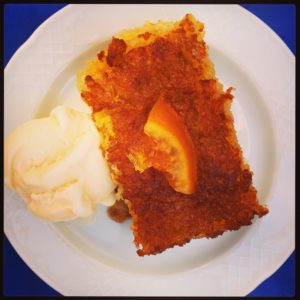
Returning home, I set to re-create Kallisto’s portokalopita.
Tweaking Vefa’s recipe, I swapped the yogurt with kefir. I was first introduced to this fermented milk drink a few years ago, while on holidays (also) in Greece. Kefir is not only rich in nutrients, such as protein, calcium and vitamins, but it also contains probiotics. These live micro-organisms (bacteria and yeasts), often described as ‘good’ or ‘friendly’ bacteria, can have various health benefits. For example, they may help sufferers with indigestion, IBS (Irritable Bowel Syndrome) and lactose intolerance. Since kefir has recently become widely available in the UK, I’ve started using it in my recipes as a substitute for yogurt or even milk.
To make it even healthier, I made one more substitution; I swapped the sugar with honey. I specifically used Greek honey that I’d brought home from Greece. The end result was as fragrant and moist as Kallisto’s. And it took me back to Amorgos. My colleagues also enjoyed it to the extent that I had to later hand out copies of the recipe.
This recipe was initially published on my blog in the summer of 2018. An updated version is included in my e-book ‘Baking Therapy: Healthy Cakes & Bakes: Recipes Inspired By My Travels’.
Karpouzenia (watermelon pie): Recipe from Folegandros
If I had to pick one fruit that takes me back to my childhood summers in Greece, this would undoubtedly be the watermelon (καρπούζι/karpouzi). During July and August, the hottest months of the year, there would always be a huge bowl with freshly cut watermelon on the table at the end of each and every family meal. The same happened when we dined out; watermelon would always be served there too. In the afternoons, I remember waking up from my nap only to find that my grandmother had prepared a slice of watermelon served with some feta cheese. Perhaps because it is ubiquitous during the summer in Greece, perhaps because when served in taverns, it is always complimentary, I’d never really thought too much about watermelon. Until I moved to the UK, and started missing the clear-blue skies, the crystalline waters, the heat, and this large oval red-fleshed refreshing fruit.
When I visited the little-known island of Folegandros, I came across a dessert called karpouzenia (καρπουζένια/watermelon pie). This is a griddle-cake made with watermelon and honey topped with sesame and usually served with ice-cream on the side.
This recipe was initially published on my blog in the summer of 2019. An updated version is included in my e-book ‘Baking Therapy: Healthy Cakes & Bakes: Recipes Inspired By My Travels’.
Kumquat cake: Inspiration from Corfu
This is one of my favorite cakes to bake and to eat. I drew the inspiration for this cake when I visited the Greek island of Corfu. Even though this small citrus fruit originates from China, it is now considered as a Corfiot trademark. It was first brought in Corfu in the middle of the 19th century by an Englishman, the botanist Sydney Merlin. Nowadays, it is mainly cultivated in Northern Corfu, near the village of Nimfes. When I visited Corfu, the kumquat was ubiquitous: in spoon sweets, ice-cream, jams, liqueurs…
Soon after I returned from Corfu back to England, I came across fresh kumquats in my local supermarket. What a wonderful surprise, I thought. Just the sight of this small fruit traveled me back to Corfu. Given my love for baking, I decided to bake a cake using kumquats as the main ingredient. So, I came up with this recipe, which is based on Nigella’s clementine cake. As I have recently been trying to reduce my sugar intake, I have substituted sugar with honey (which is why I added baking soda to the recipe).
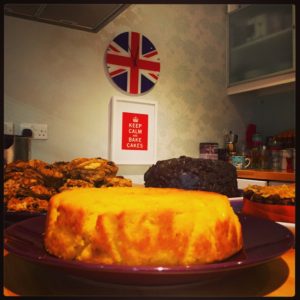
A similar recipe using clementines instead of kumquats was published on my blog in December 2018. The kumquat cake recipe has never been published before and is included in my e-book ‘Baking Therapy: Healthy Cakes & Bakes: Recipes Inspired By My Travels.
Double carrot cake: Inspiration from Amorgos
I had never heard of carrot spoon sweet until I visited the island of Amorgos. Spoon sweets are traditional desserts that can be made from most fruit, such as citrus fruits, cherries, figs, or quinces. In the past, fruits were preserved in sugar syrup to prolong their season, and this is how spoon sweets were born. Nowadays, they remain a popular dessert, usually served in a teaspoon on a small crystal or porcelain plate, along with a glass of water and/or coffee, as a welcome gesture. A spoon sweet is made with only one type of fruit, although you can also find spoon sweets made with nuts or roses (instead of fruit). In Kos, I came across spoon sweet made with tomatoes (technically a fruit), and then in Amorgos, I had spoon sweet made with carrots (a root vegetable).
This gave me the inspiration for this recipe: a hellenized carrot cake topped with carrot spoon sweet. Unlike cheesecake, carrot cake is not a dessert originating in Greece. England, France and Switzerland are all considered possible birthplaces. I, however, wanted to hellenize it, so I looked up the recipe by Stelios Parlaros, a renowned Greek pastry chef, who uses olive oil instead of butter. To make it even healthier, I substituted the sugar with honey.
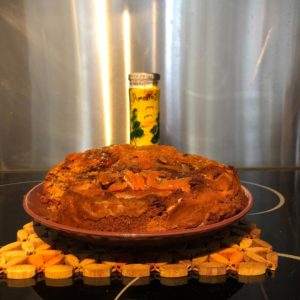
This recipe has never been published before and is included in my e-book ‘Baking Therapy: Healthy Cakes & Bakes: Recipes Inspired By My Travels’.
Sweet tomato and feta cheesecake: Inspiration from Kos
I’d always thought of cheesecake as an American dessert. It was only recently that I learned that cheesecake (albeit not quite as we know it) may have been a popular dish in ancient Greece. In fact, Aegimus, a fellow Greek physician, wrote a book on the art of making cheesecakes – the earliest mention of cheesecake in (written) history. The earliest cheesecake recipes are found in ‘De Agri Cultura’, a book by the Roman historian Cato the Elder.
Nowadays, Greeks use cheese (such as the locally-produced feta and mizithra) in baking, but these bakes are savory rather than sweet.
The inspiration for this cake came when I visited the island of Kos, a popular destination for European holiday-makers. But, the island has much more than its rich history and crystal-clear waters to offer. Another reason to visit Kos is for the local cuisine and delicacies: tomato spoon sweet, tomato jam and wine cheese. On my way back home, I had them all packed in my suitcase. Whilst unpacking, looking at these wonderful products, I came up with the idea for a sweet tomato cheesecake. It is a perfect way to showcase the tomato spoon sweet or the tomato jam. For the filling, however, I did not use wine cheese; instead, I used feta and cream cheese.
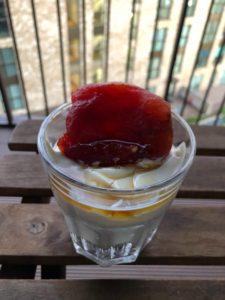
This recipe has never been published before and is included in my e-book ‘Baking Therapy: Healthy Cakes & Bakes: Recipes Inspired By My Travels’.
Vegetable and feta cheese cake: A home recipe from Thessaloniki
I was born and raised in Thessaloniki, the second-largest city in Greece. Having a rich history dating back millennia, my home town is now considered the country’s gastronomic capital, a culinary paradise.

When I was a kid growing up in Thessaloniki, the more my mother encouraged me to eat things like carrots, peas and broccoli, the more I would push them to the side of my plate. One day, however, seeing how much I loved cakes, she decided to bake a savory cake, with the vegetables I despised the most. Much to everyone’s surprise, this did the trick. And this is how I started eating vegetables.
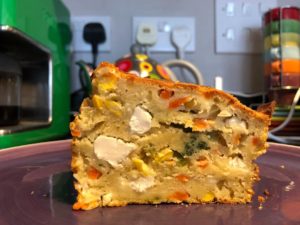
This recipe has never been published before and is included in my e-book ‘Baking Therapy: Healthy Cakes & Bakes: Recipes Inspired By My Travels’.
Banana and coconut loaf: Inspiration from the Americas
One of my favorite as well as the easiest cakes to bake is the banana loaf (or bread). Originating from the United States of America, this is actually a loaf-shaped cake. I have been baking it for quite a few years now, so I have reached a point that I have tweaked the original recipe quite a lot (in an attempt to make it healthier and guilt-free).
In 2018, I visited Martinique, a French island located in the Lesser Antilles of the West Indies in the eastern Caribbean Sea. Exotic fruits, such as bananas (a major export of the French Antilles), coconuts, papayas, guavas, mangos, and pineapples are ubiquitous on the island. You can buy them fresh in the markets, as well as in jams, desserts, juices, cocktails, sorbets or ice creams. There’s even a banana museum (la Musee de la Banane), which can be found in a working plantation near the northeast town of Saint Marie.
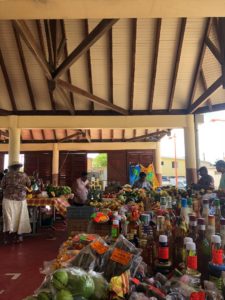
Inspired by the delicious desserts and the exotic fruit I had whilst in Martinique, I decided to tweak my banana loaf recipe once more and make it a bit more exotic. So, I came up with several recipes, including this one for a banana and coconut loaf.
This recipe was initially published on my blog in the autumn of 2018. An updated version is included in my e-book ‘Baking Therapy: Healthy Cakes & Bakes: Recipes Inspired By My Travels’.
Banana and papaya loaf: Inspiration from Martinique
This is the second Martinique-inspired tweak on my banana loaf recipe. The papaya makes it a bit more exotic. When sometimes I wonder why I came back from Martinique to rainy London, I bake this banana and papaya loaf, and the exotic aroma takes me back to the Caribbean.
This recipe was initially published on my blog in the autumn of 2018. An updated version is included in my e-book ‘Healthy cakes & bakes: recipes inspired by my travels’.
Guava loaf: Inspiration from Martinique
This is the third Martinique-inspired tweak on my banana loaf recipe. It takes me back to Vauclin, a small town on the Atlantic coast of the island, where I had a delicious dessert at ‘Rose Bleue’ at Pointe Faula. It was called ‘l’amour caché’ (hidden love) and was made with banana and guava jam.
This recipe was initially published on my blog in the autumn of 2018. An updated version is included in my e-book ‘Baking Therapy: Healthy Cakes & Bakes: Recipes Inspired By My Travels’.
Banana and avocado loaf: Inspiration from Martinique
Féroce d’avocat (fierce avocado) is a savory dish from the French Antilles. The main ingredients are mashed avocados, cassava flour (flour made from the root vegetable cassava, also known as manioc or yucca), olive oil, lime juice, salt cod, and plenty of hot chili peppers. Like guacamole, féroce is a spread; in fact, it is sometimes referred to as the Antillean guacamole.
Inspired by this ferocious dish, I came up with this much sweeter recipe for a banana and avocado loaf. Of course, I have not used salt cod or chilies, but I have kept the rest of the ingredients found in féroce. This is a somewhat different recipe compared to the previous ones; this is because of the fat composition of the avocados.
This recipe has never been published before and is included in my e-book ‘Baking Therapy: Healthy Cakes & Bakes: Recipes Inspired By My Travels.
Gâteau Nantais (rum cake): Recipe from Nantes
Earlier this year, I visited my friend Marie, who lives in Nantes, a vibrant city in western France. France is renowned for its cuisine and wine, and many cities and regions are popular foodie destinations. Nantes is not an exception. In fact, it is the birthplace of the delicious gâteau nantais. This is a light cake made of ground almonds and rum, the latter imported from the Lesser Antilles in the eastern Caribbean Sea (especially from the overseas regions of France, Martinique and Guadeloupe).
On my return to England, I adapted the recipe substituting sugar with honey. This is the only recipe included in my e-book ‘Baking Therapy: Healthy Cakes & Bakes: Recipes Inspired By My Travels’ where I am not using any fruit or vegetables.
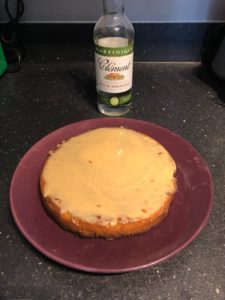
This recipe has never been published before and is included in my e-book ‘Baking Therapy: Healthy Cakes & Bakes: Recipes Inspired By My Travels’.
Mango lassi cake: Inspiration from Yorkshire
Mango and Yorkshire? This doesn’t sound quite right, does it? Well, the truth is that mangos do not grow in England, let alone in Yorkshire. However, this is exactly where I became a baker as well as a fan of this exotic fruit, which is native to southern Asia, especially Burma and eastern India.
Leeds is home to some of the best Asian restaurants in the country: Prashad, Tharavadu, Mumtaz and Bundobust. Whilst living in Yorkshire, I often dined at these restaurants. And this is how I came across mango lassi, a refreshing Indian drink made with mango, yogurt and sugar. The more I familiarised myself with these exotic cuisines and their ingredients, and the more confident I became as a baker, the more I brought these influences to my baking. And this is how my mango lassi cake was born.
This recipe has never been published before and is included in my e-book ‘Baking Therapy: Healthy Cakes & Bakes: Recipes Inspired By My Travels.
The Great British Cheesecake: Inspiration from London
I think cheesecake is a great dessert to have on those long summer days, when you want something else than ice-cream or gelato and yet you crave an equally refreshing dessert to finish off your meal. In the summer of 2012, when London hosted the 30th Summer Olympics and Queen Elizabeth II celebrated her Diamond Jubilee (marking the 60th anniversary of her accession to the throne), I became rather obsessed with anything that had the Union Jack on; unsurprisingly my cheesecake recipe suffered the same fate and soon paired with the iconic United Kingdom flag. To make it a bit less Greek and more British, I am not using feta cheese for the filling, and instead of topping it with spoon sweet, I top it with fresh berries. And this is how the Great British Cheesecake was born.
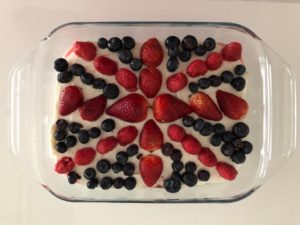
This recipe has never been published before and is included in my e-book ‘Baking Therapy: Healthy Cakes & Bakes: Recipes Inspired By My Travels’.
Cinnamon applesauce cake: Inspiration from America
I was born on the 20th of December, so Christmas is always a double celebration for me. As much as I love traveling, I tend to spend that time of year at home. A perfect opportunity to bake. Once I have put the tree up and posted my greeting cards (with Christmas classics playing in the background), I am covered in flour (and not just for the snow effect) whilst my flat smells of all those lovely Christmas scents and spicy aromas: orange, clove, cinnamon, nutmeg, ginger, and the list goes on and on… There is something profoundly calming (even therapeutic) when I mix the basic baking ingredients together: flour, butter, eggs… Perhaps, the secret is in the knowledge that I am creating something delicious to share with my friends, family or colleagues. But, when I add those Christmassy spices to the mix, it is magic.
One of my favorite festive cakes is the American-inspired cinnamon applesauce cake (or bread), another loaf-shaped cake based on the banana bread. Applesauce is popular in both Northern Europe and America, but the inspiration for this recipe came from the latter. When I last visited the US, I read the culinary mystery novel ‘Double Fudge Brownie Murder’ by Joanne Fluke, and this is where I came across the author’s version of this recipe, which I have tweaked (to give it a healthier spin). To make it even more special, I have used home-made cinnamon butter and cinnamon applesauce.
This recipe was initially published on my blog in December 2018. An updated version is included in my e-book ‘Baking Therapy: Healthy Cakes & Bakes: Recipes Inspired By My Travels’.
Nutrition and mental wellbeing
As a medical student, I learned how our diet, nutrition and eating habits can affect our physical health. For example, a diet rich in antioxidants may protect against many illnesses, including cancer.
As a Psychiatrist, I have learned about the interplay between physical and mental health. I have also learned about the complex interaction between biology and psychology. Common mental illnesses, such as depression and anxiety, as well as complex syndromes, such as chronic fatigue syndrome (CFS) and irritable bowel syndrome (IBS), exemplify this. It therefore makes perfect sense how our diet, nutrition and eating habits can affect our mental health too. At the end of the day, the distinction between mind (mental health) and body (physical health) is a rather philosophical one, since the brain is part of the human body the same way that the heart or the gut are.
Nutrition is an exciting field where new information constantly comes to light; however, this has resulted in a plethora of often confusing and contradictory information coming from various sources: scientific research, as well as online articles, blogs, social media and books.
A Psychiatrist’s nutritional recommendations
As a doctor myself, nutrition is something that I am really passionate about, since I believe it plays such an important role in both our physical and mental health, as well as our overall wellbeing. To avoid confusion, I would like to make some simple nutritional recommendations which will hopefully contribute to better physical and mental health:
1. Have three regular main meals: breakfast, lunch and dinner.
2. Have healthy snacks between the main meals.
3. Eat mindfully.
4. Eat in moderation, not too much.
5. Follow a varied but balanced diet of protein, carbohydrate and fat (use the UK Eatwell Guide or other official recommendations as a guide).
6. Eat your 5 (fruit and vegetables) a day.
7. Drink plenty of water, but drink alcohol in moderation, not in excess.
Baking and mental wellbeing
First, it is a creative activity, and as such, it can be considered as both a pleasurable and purposeful activity. For most bakers, baking is a hobby, a fun activity; they enjoy the various steps involved in the process of baking, from choosing a recipe to getting the ingredients, and from mixing the ingredients together to decorating the final product. The end result fosters a sense of achievement and boosts self-esteem, essential ingredients for a well-balanced life.
Second, the final product is often shared with family, friends or colleagues. As such, it can add an extra layer to our close (or less close) relationships; the joy experienced by our loved ones is certainly an extra reward, often greater than the fun and pleasure derived from engaging in this creative activity.
Third, home baking allows us to use fresh and nutritious ingredients, and home-baked goods are generally much healthier than shop-bought ones. For example, on a personal level, I have been mindful of the (non-negligible) amount of sugar that most cake recipes call for, and I have therefore replaced sugar with honey, as a healthier alternative.
Fourth, for many baking can be a calming and relaxing activity, a perfect antidote to the stressors of our daily lives. For some, it can even be therapeutic and help them when they feel anxious or low in mood. In fact, there are therapists who ‘prescribe’ or even build their sessions around baking.
Mindfulness in the mix
Moreover, nowadays, baking is also heralded as a mindful and meditative activity. In ‘The Art of Mindful Baking’, Julia Ponsonby explains that ‘successful baking requires us to be mindful. It needs us to be fully present with our activity, engaged in a flow that is impervious to distractions’.
As a Psychiatrist, I strongly believe that mindfulness and meditation are key ingredients for a happy and healthy life, alongside a balanced diet and a mix of pleasurable and purposeful activities. So, perhaps we could all benefit from baking a little a bit more…
Further reading
To read more on the subject of nutrition and mental wellbeing, check out my post ‘Better Nutrition. Better Health. Better Wellbeing‘.
To follow my travels around the world, simply subscribe to the Traveling Psychiatrist (subscription button on the left-hand side).
My e-book ‘Baking Therapy: Healthy Cakes & Bakes: Recipes Inspired By My Travels’ is available for FREE for every new subscription (for a LIMITED TIME ONLY).
In your homes, get set, bake!
Alex
(the London-based Traveling Psychiatrist)